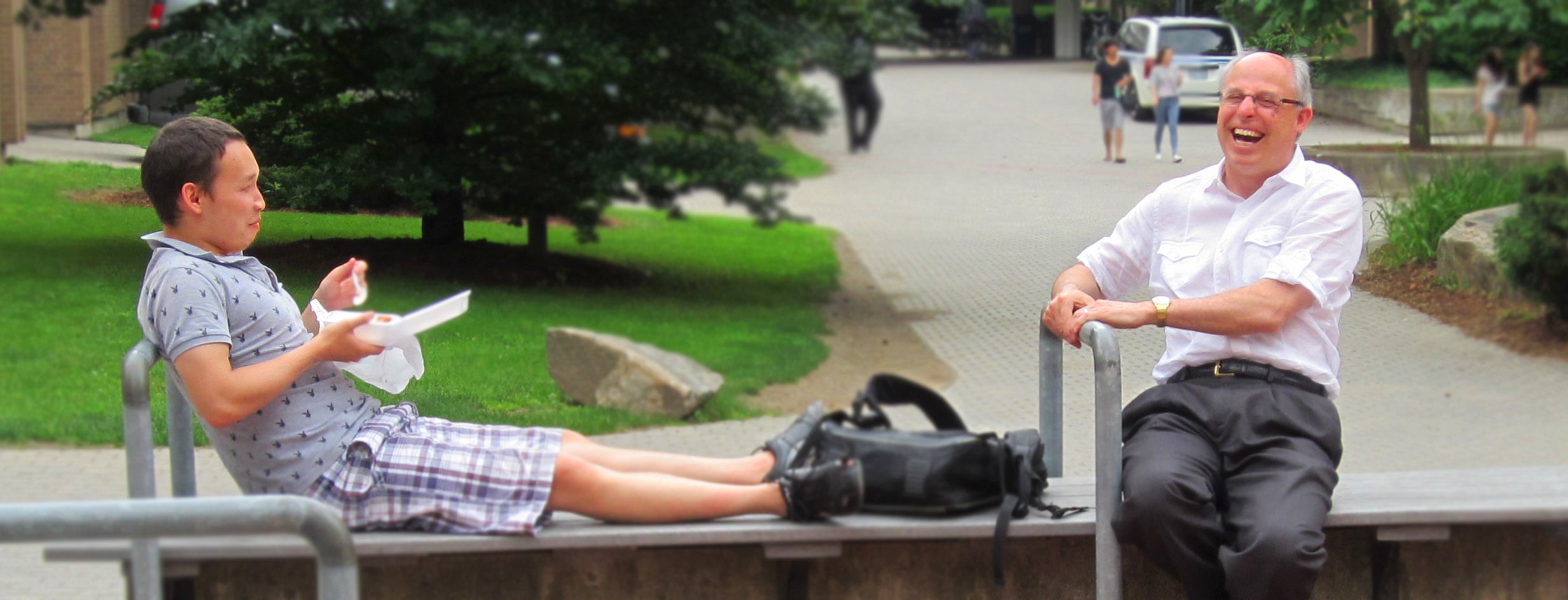Pro[o]f Perfect: Steve Furino’s Quest for Teaching Excellence
 |
| Steve Furino shares a laugh with one of his students. |
Written by Victoria Faraci, Special Projects (Teaching Stories), CTE.
What are the chances of strolling through the Peter Russell Rock Garden in front of the Math building and happening upon a student who not only knows Dr. Steve Furino, but knows him well enough to sing his praises? Apparently, pretty high. Yerzhan Kenzhegaliyev, pictured above, is a fourth-year student studying math and currently enrolled in Furino’s CO 480 class. This course uses a storytelling approach to provide historical context for mathematics. Currently, it boasts a 90% attendance rate. Kenzhegaliyev is particularly struck with his math instructor’s “knowledge outside of Mathematics” and the way that Furino brings this into the classroom. “His lectures are actually fun!” he says.
Furino is a seasoned instructor, having taught since 1981, first as a high school teacher, and now as a lecturer at Waterloo. Beyond teaching, Furino also contributes – as part of his faculty’s Centre for Education in Mathematics and Computing – to the internationally recognized math contests that Waterloo coordinates for elementary and high school students.
Throughout his diverse teaching career, from high school to university, Canada to overseas, Furino stresses that “we teach by character as much as we teach by content. Who we are matters often much more than what we teach.” He notes that it is important for math students to be able to do a “proof,” but when they get into the workplace, that ability might not be their most important skill. At that point, it will be the character of his students that will truly matter. Although fostering an environment in the classroom where students learn effectively is important to Furino, he is also well-known for providing a comfortable, supportive environment outside of the classroom for those requiring assistance during his office hours.
Media El Tayara, a 3A student in Mathematical Studies, speaks fondly of Furino’s classroom teaching, but it is his unwavering support outside of the classroom that has kept her returning to his office hours, even though she is no longer one of his students. Yerzhan Kenzhegaliyev is also eager to share the positive experiences he had meeting with Furino during his office hours. Furino modestly suggests that when it comes to impacting a student’s attitudes, an instructor’s “leverage is small”; however, his devoted following of students might suggest otherwise. El Tayara adds that Furino doesn’t seem to consider teaching a mere “job,” suggesting that it seems to be both Furino’s passion and calling.
In the classroom, Furino constantly pushes himself to try new things and to question the methods of conventional teaching. “I’ve never been satisfied with lectures… I’ve always thought that there was a better way to do it, so I started experimenting early on.” As a recent example, Furino talks about assisting with the curriculum change that took place in the Faculty of Mathematics in 2011. From this, a new online version of a course emerged: MATH 135, a first-year core course for Honours students. “On a technical side,” Furino says, “there are some things that we can do better online than in class.” As an example, he cites providing feedback to students: online courses allow instructors to make the feedback cycle almost instantaneous.
Along with this shift to online courses, Furino plans to experiment with a flipped classroom model for MATH 135 in the fall semester. Flipping a classroom means that students acquire course content outside of class time through online tutorials, so that class time can be devoted to active learning activities. Furino recognizes that many students might initially resist these changes in pedagogy. “The bulk of students,” he says, “will say that teaching is where someone stands at the front of the room and delivers content through a lecture, and if there is no lecturing, then the instructor is not doing his or her job.” But lecturing, Furino counters, should not always be equated with learning. Furino’s goal for the flipped classroom is to emphasize learning. The teaching component comes not from lectures, but from the “judicious selection of problems, some encouragement, and some duress when necessary.”
Furino says that new teaching strategies and online courses are a way for the Faculty of Mathematics to adjust to the “reality that is.” Being practical and proactive in the face of new technologies and new student expectations is an approach that Furino is happy to take. “In order to be amongst the very best in the world,” he says, “we must demand the very best not just from our students but ourselves.”
Read more Teaching Stories
Tip sheets
CTE has developed more than 100 Teaching Tips. Each one is a succinct document that conveys useful ideas and practical methods for effective teaching. Some of the Teaching Tips that are relevant to the strategies mentioned in this Teaching Story include the following: